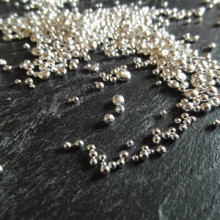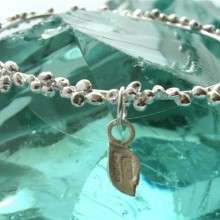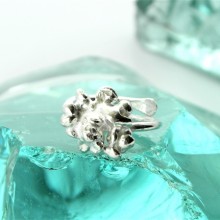The ECOLOGIST…

Can silver ever be ethical?
Matilda Lee

From country cousin to king gold, silver is slowly cleaning up its tarnished reputation, writes Matilda Lee
Goldsmiths’ Hall, with its elaborately ornate interior and centuries’ old ‘silver service’ collection, may be steeped in tradition but the 14th-century London-based hallmarking company has grudgingly accepted the need for a 21st-century ethical makeover.
‘Silver is ethical in the sense that it is never thrown away,’ says Dick Melly, clerk of the Goldsmiths’ Company. ‘Historically, the silver industry has always recycled. It can be melted down and reused again and again. The problem is getting it out of the ground.’ Quite.
For many in the industry, the only ‘ethical’ silver on the market is deemed so because it is recycled – as if the sins of a first life can be washed away – and ethically reborn. While not the best option, it is pragmatic. The reasons for this are many.
Generally, silver comes to market as a byproduct of the industrial mining of other metals, such as copper, zinc and gold. In 2005, only 30 per cent of silver came from actual silver mines. It is no high honour to be grouped into ‘one of the world’s most destructive industries’, as the industrial mining industry is known. According to the report ‘Dirty Metals: Mining, Communities and the Environment’, by Earthworks and Oxfam America, the environmental and social costs of metals mining include using as much as 10 per cent of world energy, arsenic emissions, cyanide and mercury poisoning, child labour and human rights abuses, as well as vast landscape damage.

While retailers and manufacturers of silver jewellery and silverware have become increasingly interested in ethical issues in the past few years, attention is mainly a byproduct of campaigns in the gold and diamond industry. In 2005, the National Association of Goldsmiths, which represents retailers, helped found the Responsible Jewellery Council (RJC), made up of the British Jewellers’ Association (manufacturers) as well as such industry titans as BHP Billiton Diamonds, Rio Tinto, the Signet Group and Cartier. Its aim is to tackle human rights, labour standards and environmental performance issues in the industry, and it is working on an accreditation scheme for diamond and gold jewellery supply chains. And silver? ‘Tracing metals is very difficult and expensive, and very easy to adulterate,’ says Peter Taylor, director of technology and training at the Goldsmiths’ Company. ‘It will require creating an entirely new supply chain.’
But whereas 80 per cent of gold mined each year ends up in jewellery, making it a centralised target for change and consumer campaigns, only about a quarter of the world’s silver goes into jewellery and silverware. Because of its electrical and thermal conductivity, silver has very broad usage, from plasma display panels and x-rays to its use in the fabrication of solar photovoltaic cells. Needless to say, this has made a sustained consumer campaign for greater transparency all the more challenging.
Greg Valerio, founder of Cred jewellery and the Association for Responsible Mining (ARM), begs to differ. ‘The RJC is green lipgloss,’ he argues. ‘It’s not difficult to trace, they just don’t want to do it. We do it and I’m a small company with four employees. It will mean completely opening up supply chains and the how, where and with whom they do business. It means accountability. They don’t want that.’ Greg initially sought out ethical silver jewellery, but says ‘the frustration was that we couldn’t find fair trade silver sourcing; it wasn’t there. The silver industry hasn’t received as much attention as gold or diamonds’. He is now part of a group that is helping to establish certified Fairtrade gold, which should be launched late 2009.
In July 2008, Walmart, itself the target of many a consumer campaign, introduced its Love, Earth jewellery line, which is responsibly sourced and can be traced online by entering a product code. Walmart says the line is a ‘first step’ in having all the gold, silver and diamonds sold in Walmart come from mines and manufacturers that meet criteria for responsible sourcing. It claims 10 per cent of all jewellery it sells will come from a traceable source by 2010.

What’s mined is yours…
Patrick Schein, a trader and refiner of precious metals, and founding director of the
Ethical Bullion Company, says that whereas ‘the mining industry now has techniques becoming more enviro-friendly, you can’t mine without leaving an environmental footprint. The big issue is ownership. Many mine workers struggle to earn a livelihood. The ratio of societal value in large-scale mining is much lower than in small-scale mining. Small-scale mines employ more people, don’t use up deposits as quickly and the revenue stays in the community’. There are an estimated 100 million families and dependants involved in small-scale mining throughout the world.
Jane Hope, a teacher of applied arts at Plymouth College of Arts, who also spent 20 years as a jeweller, felt her students ought to know where their materials come from. After 18 months researching ‘ethical silver’, she visited the historic heart of silver mining, above the Andean city of Potosí in Bolivia, the silver from which financed much of the Spanish empire. ‘It was a real eye-opener,’ she says. ‘Nine million miners have lost their lives in those mines over the past 450 years. Today it’s a real mess, and the current restoration project can only do so much to restore it to its initial state. The carbon footprint of the extractive industries is vast. Strictly speaking, there is no ethical silver because there is no such thing as ethical mining.’
As ethical issues become increasingly complicated so do answers to ethical dilemmas become less clear-cut. Philip Newman, a metals analyst at precious metal consultancy GMFS, says more and more of the silver used for industrial purposes is being recouped and reused. ‘A lot less is going into landfill, because of stronger environmental legislation and the fact that you can recoup
costs by selling it on,’ he says. Last year, the total ‘scrap’ or recycled silver was 5,649 tonnes out of a total of 26,241 tonnes of new silver. Every dark cloud has a silver lining.
Ethical jewellers
■ Cred Fairly traded and recycled gold and silver jewellery. www.credjewellery.com
■ La Jewellery designer Lisa Anne Dickenson uses recycled silver jewellery made in Wales. www.lajewellery.co.uk
Organizations
■ Ethical Metalsmiths connects jewelers and others in the industry with responsibly sourced materials. www.ethicalmetalsmiths.org
■ Alliance for Responsible Mining (ARM)
www.communitymining.org
■ Responsible Jewellery Council Set up in 2005, certification end March 2009. www.responsiblejewellery.com
——————————————————————————–
For ethical and sustainable suppliers of Clothing goods and services check out the Ecologist Green Directory here





Comments are closed.